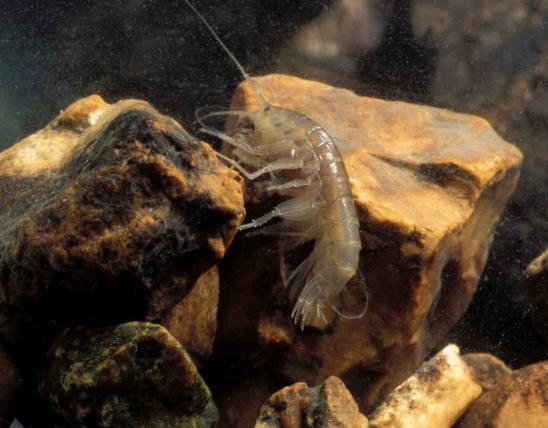
The Salem cave crayfish is one of three (possibly four) blind, white (translucent) species that occur in subterranean waters of the Missouri east-central Ozarks. Like most other cave crayfish, this species has long, narrow pincers and very long antennae. The carapace is separated at its middle by a wide space (areola); this feature helps separate it from the bristly cave crayfish, which is found in southwest Missouri, and thus in a different region.
Adult length: about 2¼ to 3¾ inches.

Occurs only in a broad area of the eastern Ozarks from Camden and Crawford counties southward to Oregon and Ripley counties. It is present in the Meramec, Gasconade, Osage, Current, Eleven Point, and Spring river drainage systems.
Habitat and Conservation
This species is most often found in cave streams and underground lakes and is sometimes collected at the mouths of springs. Substrates include rock, sand, mud, bat guano, and organic debris.
This crayfish occurs only in Missouri, in caves in a few counties in the east-central Ozarks. Because it’s fairly uncommon and has a restricted range, it is vulnerable to extirpation and extinction. Keeping groundwater clean is a key to its survival.
Food
Crayfish are generally omnivores, eating a wide variety of plant and animal materials. Because green plants are rather scarce inside caves, this species undoubtedly eats a larger proportion of animal material (as a predator of live animals, or a scavenger of dead ones) than other crayfish.
Status
A species of conservation concern in Missouri. The Salem cave crayfish is endemic to Missouri: it occurs within our borders and nowhere else in the world.
Populations seem to be secure, but this crayfish’s limited range and habitat restrictions make it a species that is vulnerable to extinction. A fertilizer spill in November 1981 seeped into the ground and wiped out thousands of these animals. That is an example of how a single incident can be devastating for a species that, in the whole world, occurs in only about nine Missouri counties.
Life Cycle
Detailed knowledge of this species reproductive cycle is not known. Crayfish molt as they grow, discarding the old shell and replacing it with a new, larger one. After mating, the female carries the eggs, then the young, under her abdomen, attached to swimmerets, which are small appendages on the bottom of the abdomen.
Human Connections
In 1981, an ammonium fertilizer spill 13 miles from Meramec Spring killed thousands of these and other crayfish, plus many sculpins and trout at the spring mouth. Incidents like this remind us that what goes into the ground eventually seeps into caves. It’s important to keep our groundwater clean.
Ecosystem Connections
Crayfish eat a variety of materials, including living and dead animal life, and this cave crayfish undoubtedly feeds on cave isopods and other animals that live in the streams in caves. Crayfish, living or dead, are in turn an important food for many other animals.




























